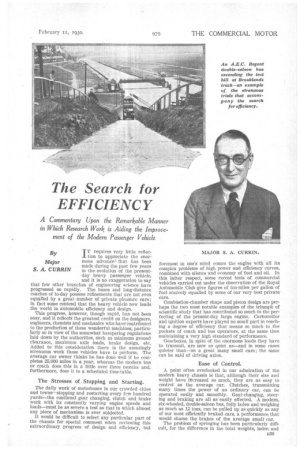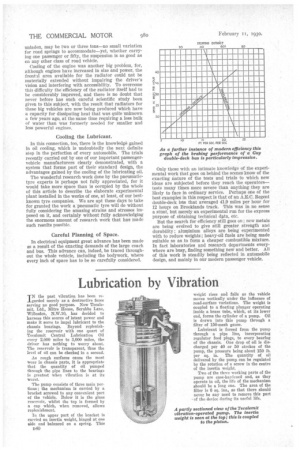The Search for EFFICIENCY
Page 133

Page 134

If you've noticed an error in this article please click here to report it so we can fix it.
A Commentary Upon the Remarkable Manner in Which Research Work is Aiding the Improve. ment of the Modem Passenger Vehicle
TT requires very little reflec
tion to appreciate the enormous anvance6,,that has been made during the past few years in the evolution of the presentday heavy passenger vehicle,
. and it is no exaggeration to say that few other branches of engineering science have progressed so rapidly. The buses and long-distance coaches of to-day possess refinements that are not even equalled by a great number of private pleasure cars; in fact some contend that the heavy vehicle now leads the world in automobile efficiency and design.
This progress, however, though rapid, has not been easy, and it reflects the greatest credit on the designers, engineers, chemists and mechanics who have contributed to the production of these wonderful machines, particularly so in view of the somewhat hampering regulations laid down by the authorities, such as minimum ground clearance, maximum axle loads, brake design, etc. Added to this consideration there is the amazingly strenuous work these vehicles have to perform. The average car owner thinks he has done well if he completes 25,000 miles in a year, whereas the modern bus or coach does this in a little over three months and, furthermore, does it to a scheduled time-table.
The Stresses of. Stopping and Starting.
The daily work of motorbuses in our crowded cities and towns—stopping and restarting every few hundred yards—the continual gear changing, clutch and brake work with its constantly varying engine speeds and loads—must be as severe a test as that to which almost any piece of mechanism is ever subjected.
It would be difficult to select any particular part of the chassis for special comment when reviewing this extraordinary progress of design and efficiency, but
foremost in one's mind comes the engine with all its complex problems of high power and efficiency curves, combined with silence and economy of fuel and oil. In this latter respect, some recent tests of commercial vehicles carried out under the observation of the Royal Automobile 1Club give figures of ton-miles per gallon of fuel scarcely equalled by some of our very best private , cars.
Combitstion-chamber shape and piston design are perhaps the two most notable examples of the triumph of scientific study that has contributed so much to the perfecting of the present-day large engine. Carburetter and ignition experts have played no small part in reaching a degree of efficiency that means so much to the pockets of coach and bus operators, at the same time maintaining a very high standard of performance.
Gearboxes, in spite of the enormous loads they have to transmit, are now as quiet as—and in some cases quieter than—on a great many small cars; the same can be said of driving axles.
A point often overlooked in our admiration of the modern heavy chassis is that, although their size and weight have increased so much, they are as easy to control as the average car. Clutches, transmitting many times the power of an ordinary car, can be operated easily and smoothly. Gear-changing, steering and braking are all as easily effected. A modern, six-wheeled, double-saloon bus, fully laden and weighing as much as 12 tons, can be pulled up as quickly as any of our most efficiently braked cars, a performance that would shame the brakes of the average small car.
The problem of springing has been particularly difficult, for the difference in the total weights, laden and unladen, may be two or three tons—no small variation for road springs to accommodate—yet, whether carrying one passenger or fifty, the suspension is as good as on any other class of road vehicle.
Cooling of the engine was another big problem, for, although engines have increased in size and power, the frontal area available for the radiator could not be materially extended without impairing the driver's vision and interfering with accessibility. To overcome this difficulty the efficiency of the radiator itself had to be considerably improved, and there is no doubt that never before has such careful scientific study been given to this subject, with the result that radiators for these big vehicles are now being produced which have a capacity for dissipating heat that was quite unknown a few years ago, at the same time requiring a less bulk of water than was formerly needed for smaller and less powerful engines.
Cooling the Lubricant.
In this connection, too, there is the knowledge gained in oil cooling, which is undoubtedly the next definite step in the perfection of every automobile. The trials recently carried out by one of our important passengervehicle manufacturers clearly demonstrated, with a system that forms part of their standard design, the advantages gained by the cooling of the lubricating oil.
The wonderful research work done by the pneumatictyre experts is perhaps not fully appreciated, for it would take more space than is occupied by the whole of this article to describe the elaborate experimental plant installed in the works of one, at least, of our bestknown tyre companies. We are apt these days to take for granted the work a pneumatic tyre will do without fully considering the amazing strains and stresses imposed on it, and certainly without fully acknowledging the enormous amount of research work that has made such results possible.
Careful Planning of Space.
In electrical equipment great advance has been made as a result of the exacting demands of the large coach and bus. This advance can, indeed, be traced throughout the whole vehicle, including the bodywork, where every inch of space has to be so carefully considered. Only those with an intimate knowledge of the experimental work that goes on behind the scenes know of the exacting nature of the tests and trials to which new ideas are subjected before they reach the operators— tests many times more severe than anything they are likely to face in ordinary service. Perhaps one of the best examples in this respect is that of an A.E.C. Regent double-deck bris that averaged 41.9 miles per hour for 12 hours on Brooklands track. This was in no sense a stint, but merely an experimental run for the express purpose of obtaining technical data, etc.
But the search for efficiency still goes on ; new metals are being evolved to give still greater strength and durability ; aluminium alloys are being experimented with to reduce weights; heavy-oil fuels are being made suitable so as to form a cheaper combustible mixture. In fact laboratories and research departments everywhere are busy, finding something new and better. All of this work is steadily being reflected in automobile design, and mainly in our modern passenger vehicle.




























































































































































































































